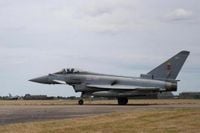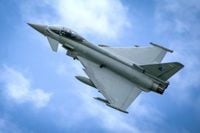Residents across Essex and neighboring counties found themselves at the center of a dramatic and unusual event on Friday, August 15, 2025, as a thunderous sonic boom reverberated through the air. The cause? Two Royal Air Force (RAF) Typhoon fighter jets streaking across the sky at supersonic speed, scrambled to intercept a private jet that had lost contact with air traffic control. The incident, which unfolded late in the morning, sent shockwaves—both literal and figurative—through communities from Cambridgeshire to Kent, and left many wondering what exactly had happened above their heads.
According to BBC and confirmed by multiple local outlets, the commotion began around 11:35am when a San Marino-registered private aircraft, en route from Nice, France, lost communication with air traffic controllers while flying over Cambridgeshire. The sudden radio silence triggered a rapid response: two Typhoon jets launched from RAF Coningsby in Lincolnshire under the RAF's Quick Reaction Alert (QRA) protocol. Their mission was clear—intercept the unresponsive plane and ensure the safety of both its occupants and those on the ground.
The supersonic dash of the Typhoons produced a sonic boom, a phenomenon rarely experienced over land in the UK due to strict aviation regulations. As Kent Online reported, residents in southern Essex, Cambridgeshire, Suffolk, Kent, and even parts of London heard what many described as a "vacuum-style" bang. Jenny Coxal, a Dartford resident, recounted, "I thought it was someone hitting our garage, but when I went outside, all our neighbours were on the street, wondering what had happened." Social media quickly filled with similar accounts, with one witness posting, "Sonic boom just heard over Hornchurch. Eurofighter Typhoon FGR4 went overhead." Another resident in Bury St Edmunds, Suffolk, said the noise "rattled" her back door, while someone in north Kent remarked that it "shook the whole house—we thought there had been an explosion."
But what exactly is a sonic boom? As explained by the US Air Force and cited in The Independent, a sonic boom is an impulsive noise, akin to thunder, created when an object travels faster than the speed of sound—roughly 750mph at sea level, though it can vary with altitude. When an aircraft breaks this barrier, it generates shockwaves that compress and decompress the air, resulting in a sudden, explosive sound. These shockwaves follow the aircraft along its flight path, and their intensity depends on altitude, maneuvering, and weather. At higher altitudes, the boom's pressure is lower but its reach is broader; closer to the ground, the effect is more intense but covers a smaller area.
Community exposure to sonic booms is generally safe, according to the US Air Force. Most homes can withstand the pressure generated, which is typically less than half a kilogram per square foot—well below the threshold for structural damage. That said, the experience can be startling. As one woman in Burwell, Cambridgeshire, wrote, "Thought something blew up in my loft." In Gidea Park, another resident described the sound as "like thunder."
The RAF Typhoon jets at the heart of the incident are formidable machines. Each can reach speeds up to 1,381mph—nearly twice the speed of sound—and operate at altitudes of up to 55,000 feet. As of February 2023, the RAF maintained a fleet of 137 Typhoons across seven squadrons, according to The Independent. These jets are supported by Voyager refueling aircraft, which allow them to remain airborne over long distances, ready to respond to emergencies like the one on Friday.
Once the Typhoons caught up with the private jet, communication was quickly re-established. The civilian aircraft, still under escort, was directed to Stansted Airport in Essex—a major transport hub well-equipped to handle such situations. Emergency services, including Essex Police and the East of England Ambulance Service, were dispatched to the airport but stood down after determining there was nothing amiss. An Essex Police spokesperson confirmed, "A flight has been escorted into Stansted Airport after it lost contact with the ground. Contact was re-established with the plane, which had been travelling from Nice, and was escorted into the airport by RAF aircraft. On the ground, our officers determined there was nothing of concern." The RAF, for its part, stated, "We can confirm that RAF Quick Reaction Alert Typhoon fighter aircraft from RAF Coningsby were launched today to investigate a civilian aircraft which was not in contact with air traffic control. Communications were re-established and the aircraft was safely escorted to Stansted. The Typhoons are returning to base."
For many, the most dramatic aspect of the morning was the sound itself. Reports poured in from Chelmsford, Ongar, Brentwood, and further afield. Residents described the boom as a "very large explosion," with some likening it to a bomb going off. The noise was so widespread that EssexLive, a local news outlet, received messages from as far away as Cambridgeshire and Kent. One social media user posted a flight tracker image showing a Eurofighter Typhoon escorting a plane to Stansted, noting, "Causing the sonic boom all over Essex. People heard it as far as Bexleyheath!"
The incident also sparked a flurry of activity among emergency services and government agencies. The Ministry of Defence, Essex Police, and Stansted Airport all fielded inquiries from concerned citizens and journalists. The East of England Ambulance Service and Essex County Fire and Rescue Service were also contacted, though both stood down once it became clear there was no threat to public safety.
Curiosity about the event lingered even after the all-clear was given. Many residents, having never experienced a sonic boom before, sought explanations. Under UK law, supersonic flights are generally prohibited over land unless operationally required. In this case, the urgency of intercepting an unresponsive aircraft justified the rare exception. As BBC noted, the Typhoons were "authorised to transit at supersonic speed for operational reasons."
While the episode ultimately proved harmless, it served as a vivid reminder of the RAF's readiness and the swift, sometimes startling, measures taken to ensure national security. For those on the ground, it was a morning they won't soon forget—a sudden, mysterious bang that turned out to be the sound of vigilance in action.
With the skies quiet once more and Stansted Airport operating as normal, the incident stands as a testament to rapid coordination between military and civilian agencies, and to the power of sound to capture the attention—and imagination—of an entire region.





